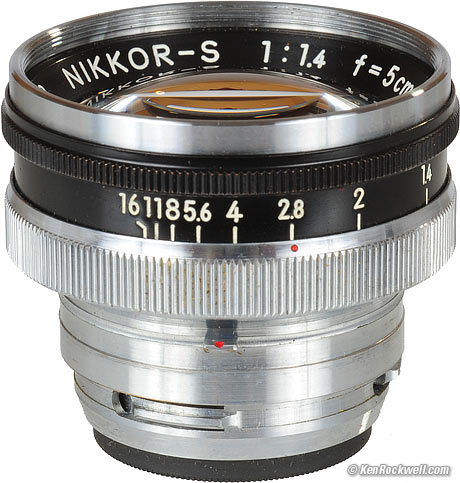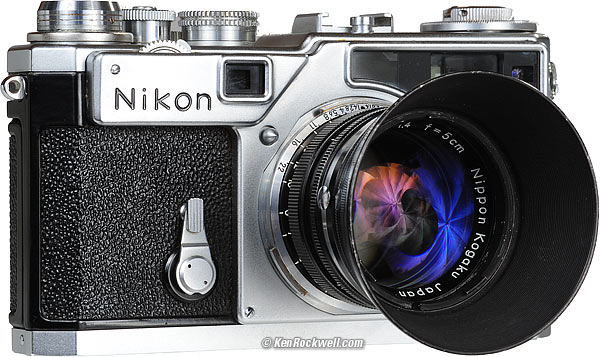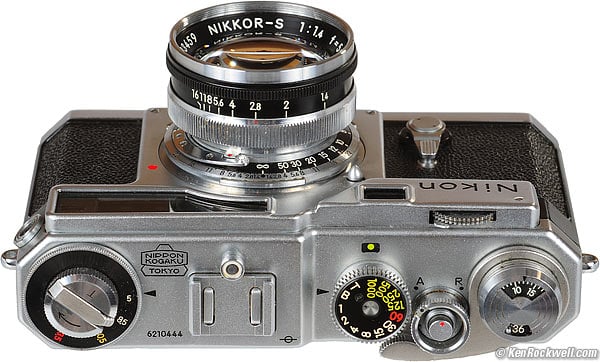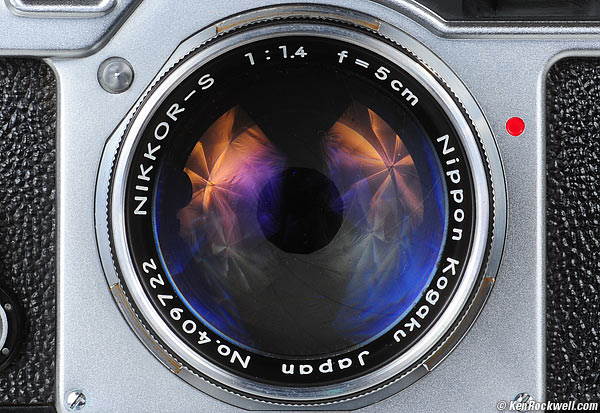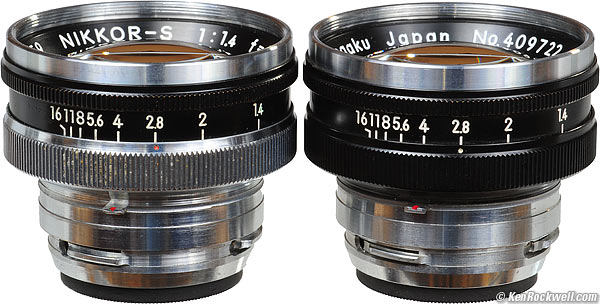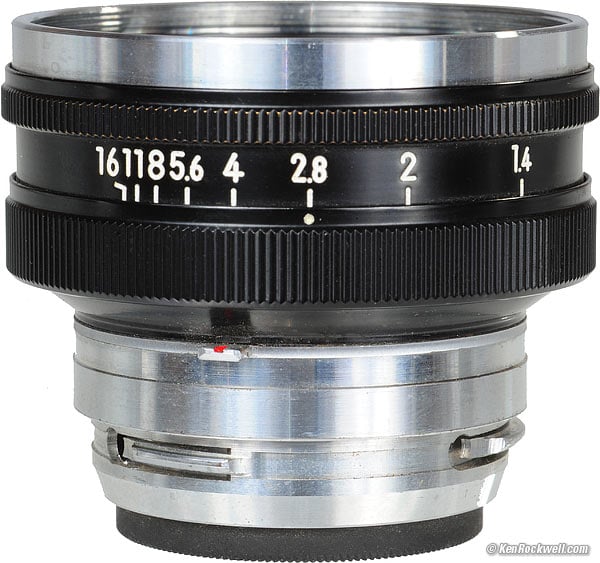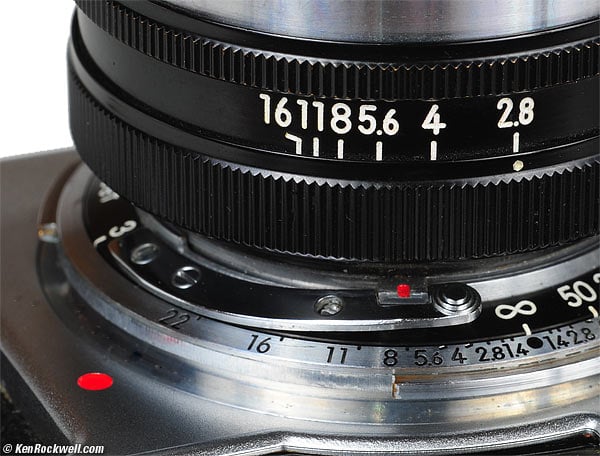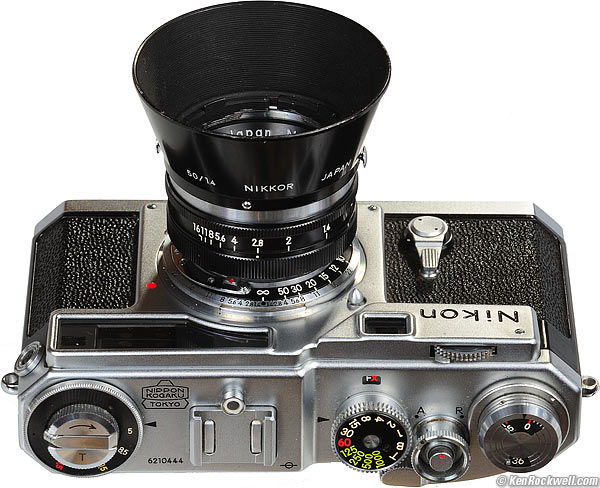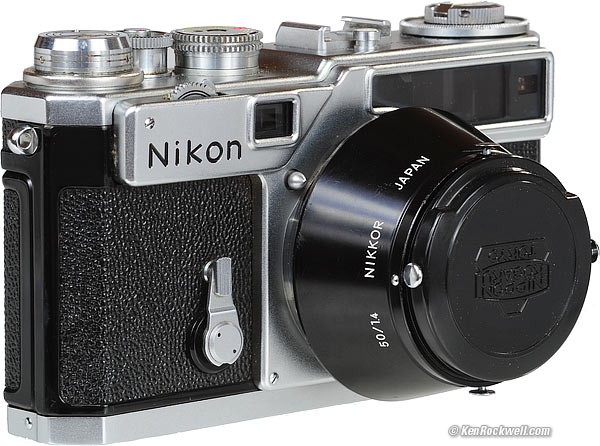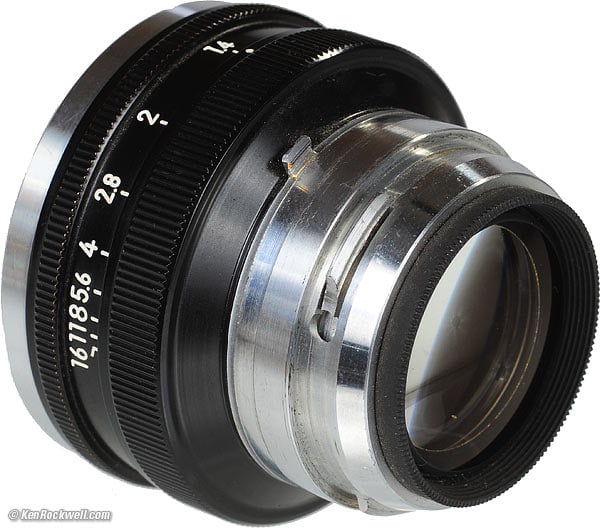Home Donate New Search Gallery How-To Books Links Workshops About Contact
NIKKOR-S 5cm f/1.4
World's First 50mm f/1.4 (1950-1962)
© 2008 KenRockwell.com. All rights reserved.
Nikon NIKKOR-S 5cm f/1.4 (43x0.5mm filters, 5 oz/150g). enlarge. The biggest source of support for this free website is when you use these links, especially this direct link to this lens at eBay (see How to Win at eBay) when you get anything, regardless of the country in which you live. Thank you! Ken.
May 2008 Nikon Rangefinder System Nikon SLR System All Reviews
Intro Specs Performance Usage Recommendations
The NIKKOR-S 5cm f/1.4 (50mm f/1.4) was a popular standard lens for Nikon's rangefinder cameras of the 1950s.
It was the world's first f/1.4 lens for any 35mm camera. In true marketing form, it wasn't that big a deal. Zeiss' earlier lens of which this is a copy was f/1.5, only one-fifth of a stop slower, but at least this lens got us to the full stop at f/1.4.
It's much smaller than AF 50mm f/1.4 lenses because it's only an optical tube without a focus helicoid. It's the size of a golf ball and its solid metal-and-glass construction weighs only 5 oz (150g).
Its optics are inferior to modern lenses at large apertures (f/1.4) due to all the veiling caused by spherical aberration, but stopped down (f/5.6 and smaller) its performance is decent for 99% of things you'd shoot with it, but still not as good as 1970s 50mm f/1.4 SLR lenses.
It is nowhere near as good as the LEICA SUMMILUX 50mm f/1.4 against which it competed — and lost — later in its life.
The smaller apertures are very close together on the aperture ring, so fractional settings can be imprecise above about f/5.6.
Compatibility
These lenses mount only on Nikon's old rangefinder cameras. Some smaller percentage were made in mounts for other brands of olde-tyme rangefinder cameras.
Nikon's best rangefinder camera is the Nikon SP (1957-1962), and this lens works on all of the rangefinder cameras made from 1948-1964, like the M, S, S2, S3 and etc.
These can't mount to any digital camera today, but are easy to shoot digitally. Simply shoot film, and have the lab scan the film as it's developed.
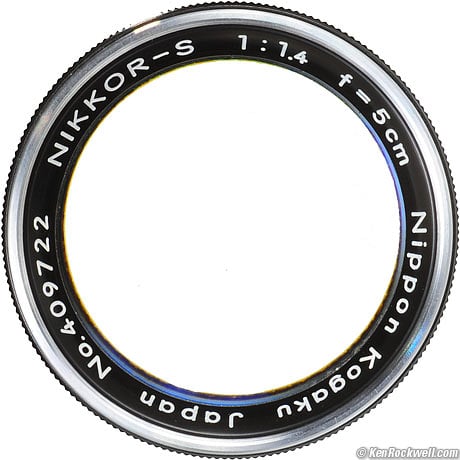
Photon's-eye view at f/1.4.
History
The 5cm f/1.4 was introduced at the end of 1950 and made until 1962. It had the same optics for 12 years, but just like today, the external cosmetics were changed often to keep people thinking they needed to buy the latest version.
Like all Nikon rangefinder lenses, the first versions were marked "NIKKOR-S C" to denote "coated," which was advanced technology for 1950. The "C" was dropped in about 1957, at which time all competitive lenses were coated, too.
Nikon choked out about 100,000 of these over 12 years. The two I'll show in this review are both from about 1958. Earlier and later versions came in different variations of black and chrome.
List price in 1951 was $1,650, corrected for inflation in 2008. The prices dropped as the years ran on, and actual selling prices averaged about the equivalent of just over $1,000. Cameras were not cheap in the 1950s, and Nikons were third-rate cameras behind Leica and Contax.
In 1962, when these rangefinder cameras were already obsolete but still manufactured, Nikon introduced a physically longer version of the 5cm lens with different optics, engraved "50mm" instead of "5cm." This is different from the lenses I'm reviewing here. Collectors call this version "Olympic," as it came out about the same time as the Tokyo Olympics. Nikon re-made the larger 50mm lens in 2000 as part of a commemorative S3 set.
Nikon SP with 5cm f/1.4 and hood. enlarge.
Specifications back to top
Intro Specs Performance Usage Recommendations
Name
Nikon calls this the NIKKOR-S 5cm f/1.4.
NIKKOR is Nikon's brand name for their lenses.
S stands for the Latin "Sept," or seven, meaning seven elements.
Focal Length
50mm (5cm).
Optics
7 elements in 3 groups.
Conventional spherical design with two cemented triplets on either side of the diaphragm, and another single element in front. Single-coated in blue and amber.
Diaphragm
12 blades for a perfectly circular opening at every setting.
Close Focus Distance
3 feet (0.9m), set on the camera.
Filter Thread
43mm, 0.50mm pitch (43E).
Newer filters are 0.75mm pitch, (43ES), so watch it: do not force a filter onto the lens.
A new 43mm filter will seem to fit, then bind after you've screwed it in a turn or two. Don't push it any farther.
Mount
Nikon S rangefinder, internal bayonet. Other mounts were available for different rangefinder cameras.
Size
1.615" long by 1.850" diameter (41.01 x 47.00mm), measured.
Weights
Lens: Silver: 5.362 oz. (152.0g). Black: 5.032 oz. (142.7g), measured.
Front Cap: 0.178 oz. (5.0g), measured.
Hood: 0.590 oz. (16.67g), measured.
Nikon NIKKOR-S 5cm f/1.4 on an SP. enlarge.
Performance back to top
Intro Specs Performance Usage Recommendations
Bokeh Bubbles Distortion Falloff Hood Sharpness
As an historic lens, it's soft on the sides at larger apertures, and as sharp as modern lenses by f/5.6.
Nikon NIKKOR-S 5cm f/1.4 at f/4 on an SP. enlarge
Bokeh back to performance back to top
Bokeh on backgrounds is poor at middle apertures.
Almost everything is mushy at f/1.4, so the bokeh is probably OK.
Bubbles back to performance back to top
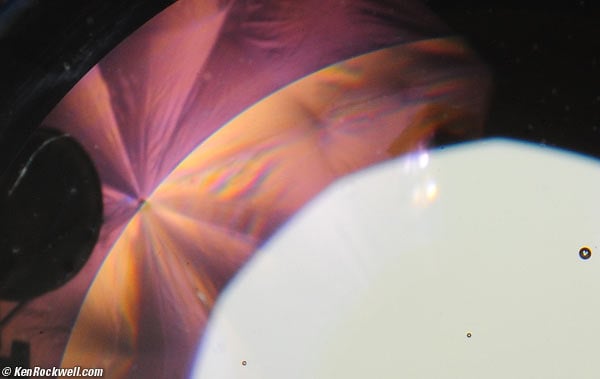
Three microscopic bubbles.
Back in the good old days, making glass was even more of a pain than it is today.
The bubbles are leftover from when the sand and other materials were melted and stirred to make glass. Today we heat the mix electrically (liquid glass is a good enough conductor) and under a vacuum to remove the air bubbles.
Some special kinds of optical glass used back then were especially susceptible to these microscopic bubbles. This is why instruction sheets of the era always said something like "tiny bubbles are a sign of high-quality glass and are in no way a defect or will they affect picture quality," to try to prevent weenies from returning perfectly good lenses.
Bubbled lenses are especially prized by collectors. This lens still has 1950s air in it, forever!
These bubbles are invisible to the eye. To the eye, the biggest bubble on the right looks like a tiny speck of black dust, and the others are entirely invisible. These are visible only under high magnification as shown above.
Distortion back to performance back to top
Unlike SLR lenses, which often have barrel (bulging) distortion, this fast rangefinder lens has a small amount of pincushion (sucking) distortion.It's easy to correct the distortion from scanned film by plugging these figures into Photoshop CS2's lens distortion filter. These aren't facts or specifications, they are the results of my research that requires hours of photography and calculations on the resulting data.
infinity |
-1.2 |
12' (4m) |
-1.0 |
© 2008 KenRockwell.com
Falloff (darkened corners) back to performance back to top
Strong at f/1.4 and f/2.
Minimal at f/2.8.
Gone, for photographic purposes, by f/5.6, although if you're shooting walls, it's best by f/11.
Hood back to performance back to top
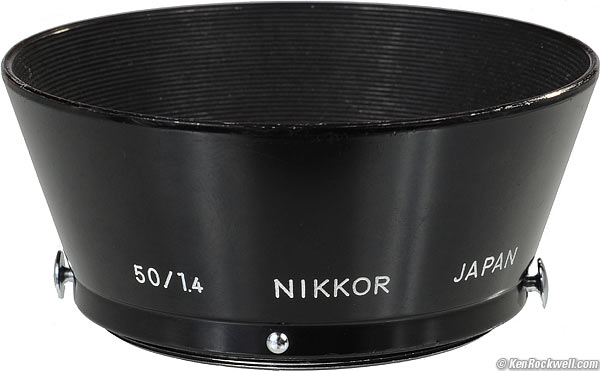
Hood for 50mm f/1.4, 43mm springy thread.
Oddly, the standard conical hood, engraved for the 50mm f/1.4 lens, causes some very slight vignetting (corner darkening)! I doubt you'd notice it looking at pictures, but if you shoot digitally (on the potentially upcoming Nikon SPX digital rangefinder) and click between images made with and without, you can see it.
Not only that, but it blocks some of the viewfinder of the SP. What was Nikon thinking? This is the worst hood ever! It's got to be the correct hood; it's engraved forever with the lens for which its designed.
A proper hood for a rangefinder lens is conical, but pointed in the other direction. A proper rangefinder lens hood has slots cut in it so the viewfinder sees right through it. In other words, the cone should be fat at the camera, have a hole cut in the back through which the finder sees, and tapers down as it goes forward so the finder sees only the edge of the cone.
Oh well. In Nikon's defense, there is a small probability that this hood, marked 50mm and not 5cm, might actually be some sort of ultra-rare collectors' item for the larger 1963 "Olympic" 50mm lens, and not for the lens I tested. Collectors would fall over themselves to pay $1,000 or more for an original hood for the "Olympic" lens, but to me it looks like the same thing as the hoods for the 5cm lens. Worse, since the "Olympic" is a longer lens, this hood would block even more of the viewfinder! What a sucky excuse for a hood.
In any case, I need to try one of the common modern-day 43mm vented hoods, which sell for about $12.95, which ought to work far better.
Sharpness back to performance back to top
On Fuji Velvia 50:
f/1.4: Images have a very sharp core with a dreamy low-contrast surround. It's got a veiled look. It looks like a very sharp version of putting a stocking over the lens, but unlike using a stocking, the core image remains very sharp. Bright edges spread into darker areas. This is caused by spherical aberration.
Corners have more of this effect, while the center is less affected.
f/2: Less veiling than f/1.4, still a sharp core surrounded by veil.
f/2.8: The veiling is gone. It's now sharp and contrasty throughout most of the image, but still softer at the sides.
f/4: The sides and corners are getting better.
f/5.6: The sides and corners are now quite good.
f/8: Sharp and contrasty even in the far corners.
f/11: Optimum aperture for the far corners.
f/16: Slightly lower contrast due to diffraction.
Two similar versions. Silver is slightly older than the black. enlarge.
Usage back to top
Intro Specs Performance Usage Recommendations
Ergonomics Removal Mounting Focusing Order of Operations Stowage
Ergonomics back to usage back to top
Nikon NIKKOR-S 5cm f/1.4. enlarge.
Small apertures are close together, so fractional settings can be difficult to set precisely.
There are two aperture scales set 180 degrees apart. Since the entire lens rotates 270° with focus, you need the repeated scales because one scale often has rotated to the bottom of the lens.
The wider ribbed ring is the lens body. It's easy to grab for mounting and unmounting, and also serves as a focus ring.
This lens has no helicoid. It is focused by the camera's own helicoid. You can focus the camera either with the camera's own finger wheel, or by turning the larger ribbed band, which will turn the lens in the camera's focus helicoid.
On the SP, use the largest frame in the main finder for composition. Set the SP's top left ring to "5," for 5cm, to hid the other frame lines.
Removal back to usage back to top
Nikon NIKKOR-S 5cm f/1.4 mounted on an SP. enlarge.
To remove the lens, set the camera to infinity (∞) as shown above.
Push down the release lever (just to the left of the ∞ symbol).
Rotate the lens clockwise until the red tab on the lens until its opposite the big red dot on the camera body.
Lift straight out.
Mounting back to usage back to top
Set camera's focus to infinity (∞).
Line up the red dots on the lens and the camera body.
Gently push the lens straight in.
Rotate counter-clockwise until it clicks into position as shown above.
Focusing back to usage back to top
Hooded Nikon NIKKOR-S 5cm f/1.4 on an SPX digital body (prototype). enlarge. (format control, set to FX, is just above the shutter speed knob.)
The lens is locked into the helicoid mount of the camera body. The lens has no focus helicoid of its own.
You may focus with the camera's own focus wheel. It's the sharply toothed wheel seen in the photo above, between the "Nikon" logo and the shutter release.
You may also turn the lens itself. Use the wider ribbed ring so you don't knock the aperture setting.
Order of Operations back to usage back to top
Nikon designed these cameras so you can do everything with just three fingers: focus with your middle finger, shoot with your pointer, and wind with your thumb.
Hint: especially on a tripod, it's difficult to focus without knocking the aperture ring. Set the aperture first, then focus, shoot and wind. The natural progression of aperture, focus, shoot and wind follows a linear progression along the camera.
Stowage back to usage back to top
Nikon 5cm f/1.4 and hood stowed on an SP. enlarge.
Nikon's caps and hoods of this era used spring-loaded threaded rings to keep them attached. You press the opposed shiny silver buttons to compress a ring to move a hood or cap.
This sounded nice, but those little mushroom-headed buttons catch on everything and pull themselves off.
You should attach the hood to the lens first, and then attach the cap to the hood. If you put the cap on the hood first, it's very difficult to compress the hood's ring.
Attach them with the silver nubbins at 90 degree angles as shown. If you do what's natural and attach them with the buttons in the same position for each, you won't be able to press them individually to remove. If you try to press the hood's buttons with the cap attached, it's nearly impossible because the cap's threads are jammed tightly inside the hood's threads.
Disassembly (don't do this) back to usage back to top
Rear view, NIKKOR-S 5cm f/1.4. enlarge.
The black knurled ring on the rear is what holds the lens optics to the camera mount bayonet. Nikon sold these lenses for other cameras, and this is how they would change the rear mechanics to fit. One set of optics can be used to fit Nikon, Contax or whatever.
Nikon did this for their convenience. Today, it doesn't mean anything except a way for you to screw up a perfectly good lens. Don't touch it; the silver lens you see pictured here is messed up and that's probably how it happened.
Beware online offers for incomplete lenses. I've seen people trying to pawn off lenses missing their mounts and retaining rings. Sure, the optics might be good by 1950s standards if you have your own machine shop to dedicate to mounting it to something, but since we no longer can buy mounts alone (not that Nikon sold them separately 50 years ago either), a lens missing its mount is useless.
Recommendations back to top
Intro Specs Performance Usage Recommendations
This lens works great on an SP. Stop it down to f/11 and its optics are almost up to par with modern optics, which isn't sayign a whole lot. As obsolete rangefinder lenses go, these 5cm f/1.4 lenses aren't expensive in 2008, about $200 ~ $400 used.
An intelligent person would take that same money and instead get a new 50mm f/1.4 AF-D which has far superior performance, or save money and get a new 50mm f/1.8 AF-D which also has far superior performance, but collectors don't worry about optical quality or utility.
I'd like to try the slower f/2 version, which may have higher performance since it's not trying to set speed records like this lens. Back in the 1950s, these were the lenses which set our expectations of faster lenses trading lower performance in exchange for faster speeds.
Acknowledgment
Many thanks to Beverly Hills pediatrician and photographer Morris Naiditch, M.D., whose forethought in buying this Nikon SP new in 1958, and keeping it out of the hands of collectors, allowed me to review it today.
Help me help you top
I support my growing family through this website, as crazy as it might seem.
The biggest help is when you use any of these links to Adorama, Amazon, eBay, Ritz, Calumet, J&R and ScanCafe when you get anything, regardless of the country in which you live. It costs you nothing, and is this site's, and thus my family's, biggest source of support. These places have the best prices and service, which is why I've used them since before this website existed. I recommend them all personally.
If you find this page as helpful as a book you might have had to buy or a workshop you may have had to take, feel free to help me continue helping everyone.
If you've gotten your gear through one of my links or helped otherwise, you're family. It's great people like you who allow me to keep adding to this site full-time. Thanks!
If you haven't helped yet, please do, and consider helping me with a gift of $5.00.
As this page is copyrighted and formally registered, it is unlawful to make copies, especially in the form of printouts for personal use. If you wish to make a printout for personal use, you are granted one-time permission only if you PayPal me $5.00 per printout or part thereof. Thank you!
Thanks for reading!
Mr. & Mrs. Ken Rockwell, Ryan and Katie.
Home Donate New Search Gallery Reviews How-To Books Links Workshops About Contact
first written 09 May 2008
